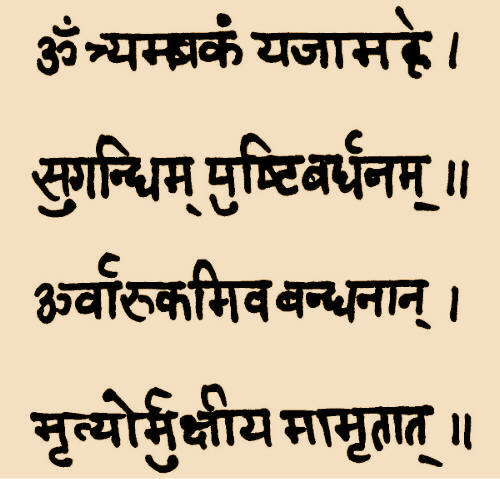|
|
Mahamrityunjaya Mantra Mahamrityunjaya Mantra (maha-mrityun-jaya) is one of the more potent of the ancient Sanskrit mantras. Maha mrityunjaya is a call for enlightenment and is a practice of purifying the karmas of the soul at a deep level. It is also said to be quite beneficial for mental, emotional, and physical health.
Om Tryambakam Yajamahe We Meditate on the Three-eyed
reality Audio Podcast:
------------------------------ AUM/OM: Absolute reality. That which encompasses the three states of waking, dreaming, deep sleep, represented by AUM, the three levels of gross, subtle, causal, the three levels of conscious, unconscious, subconscious, and the three universal processes of coming, being, and going. Absolute silence beyond the three levels is the silence after AUM. Tryambakam: Trya means three. Ambakam means eyes. It means the three eyes of the Absolute, which are the processes of creation, existence, and dissolution, as well as the other triads, which are part of AUM. The three "eyes" means experiencing these three stages and triads at one time, from the higher, all pervasive vantage point of the Absolute. Yajamahe: We rejoice in meditation on all of this. ------------------------------ Sugandhim: Means fragrance. Like a spreading fragrance, all of this permeates the whole of existence, while at the same time being that existence Pushtivardhanam: Means that which sustains and nourishes all. Thus, the fragrance that permeates all is the sustainer of all beings, while also the essence of all beings. ------------------------------ Urvarukamiva: Urva means big and powerful. Arukam means disease, like the spiritual diseases of ignorance and untruth, which are like the death of Wisdom or Truth. Bandhanan: Means bound down, as in bound down to the ignorance and untruth. ------------------------------ Mrityor: Means ignorance and untruth. Mukshiya: Means liberation from the cycles of physical, mental, and spiritual death. Maamritat: Means please give me rejuvenating nectar, so as to have this liberation, like the process of severing the cucumber from the creeping vine. ------------------------------ 40 day practice The period of 40
days has been widely recognized as an auspicious period both in
the East and the West since ancient times. A traditional way to do
an extended mantra practice is to choose a number of repetitions
per day
Listening to this online Mahamrityunjaya mantra recording of 108 repetitions (18 minutes) is equivalent to one round of a mala. A mala is a set of counting beads with 108 beads. Only 100 are counted, with the other 8 considered an offering to the divine, however you personally hold that. You might choose to do 1, 2, 3, or 4 rounds of 108 mantras per day, counting with a set of mala beads. Or, you can use the Mahamrityunjaya Mantra CD instead of the mala beads, as the CD has 4 tracks of 108 repetitions each. You might choose to do 1, 2, 3, or 4 tracks of 108 mantras per day. You might also want to alternate between doing some with the recording and some without, counting instead with a set of mala beads. It has been said that there is freedom in discipline; choosing to do a regular practice frees the mind from wondering what practice will be done that day. It is also important not to do the mantra practice with rote repetition, but rather, with feeling and awareness. By running your own experiment for 40 days, you can decide for yourself whether or not the practice is beneficial. Extended practice A noticeable level of mantra siddhi (power of the mantra) is said to come with 125,000 repetitions of a mantra (Such an extended practice is called a purascharna). This is equivalent to 1250 rounds of a mala. Listening to this online Mahamrityunjaya mantra recording of 108 repetitions (18 minutes) is equivalent to one round of a mala (Or, you can also use the Mahamrityunjaya Mantra CD). To complete the equivalent of 1250 rounds of a mala, or a total of 125,000 repetitions of Mahamrityunjaya mantra, will take this amount of time:
Such an extended practice with Maha Mrityunjaya mantra can have a tremendous effect in stabilizing the mind in preparation for advancing in meditation. Such a practice simply must be done personally to understand the benefits. It does take quite a commitment to do this practice every day for such a long period, but it is well worth the effort. In choosing the level of practice per day, it is important to have stability from one day to the next, and to not skip any days. It is best to choose the level that works for you consistently, rather than changing the number from day to day. For example, if two rounds per day is a good number (34 minutes), then it's better to stay with that amount each and every day, not to do none on one day, but four on the next day.
-------
|
|
||||||||||||||||||||||||||||||||||||||||||||||||||

